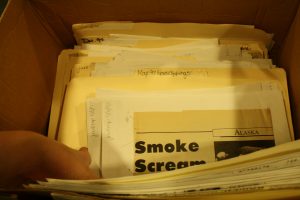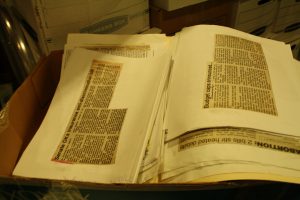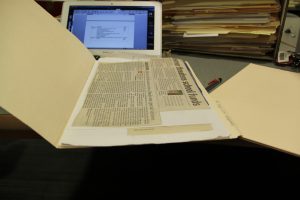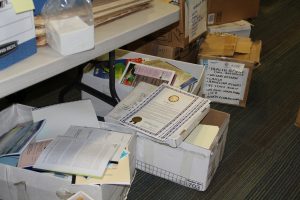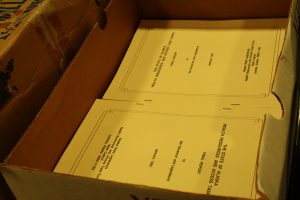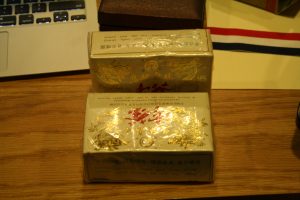When we tell people we permanently remove material (mostly news clippings) from collections, you can almost hear them gasp. When I have had to explain why newspapers are not archival according to our collection policy, they seem to understand. The Johnny Ellis papers contained a great mixture of most types of material we do not typically keep in collections, therefore I will mostly use his papers as an example. And before I delve into the explanation of everything that we do not keep, I will say that this is not universal. We do not remove every object or news clipping from collections. And as always, other archives do things differently.
News clippings
First, I did not remove every news clipping in the Johnny Ellis papers. There were some within Ellis’s bill files, notes, and constituent correspondence. In these cases, they provided context to other material in the folder, and he (or someone in his office) would heavily underline and highlight portions of those clippings. However, there were also many binders of news clipping glued to white paper or folders filled with copies of clippings.
Many of these articles related specifically to Ellis or one of his fellow legislators–every time their name appeared in an article, it was cut out and placed in a binder. Names in these clippings were highlighted, but that was all. These do not need to be a permanent record within this collection and are also available online through databases and/or on microfilm (most of the clippings were either from the Anchorage Daily News or the Anchorage Times). News clippings can also be hard to preserve, even in our climate controlled vault, and take up space and our time which can go to unique, one of a kind material.
So, what do we do with the publications?
While going through the Johnny Ellis papers, I pulled the publications and set them aside. As an archive, we generally do not collect published material, but that doesn’t mean we will throw it away. I will go through all the boxes of the publications I set aside and check for each one in the Consortium Library catalog and the WorldCat database. (We do this for every collection). If they are annotated, I set it aside to go into our Rare Books collections. They will also be placed in Rare Books if they are not in most other libraries in Alaska. Also, some publications may only have one copy at the Alaska State Library (for example), so I will put the copy I have in Rare Books. When there are many copies of a book, including at least one in the Alaskana Collection at the Consortium Library, I will set those aside as well. The current book in Alaskana may eventually be swapped out for one that is in better condition. Once I finish checking all of the publications, I will put them in boxes and set them on a special shelf in the Library’s Technical Services Department to be cataloged. Once they are cataloged, they will then be available in Rare Books.
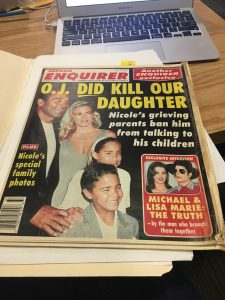
No, Ellis did not keep this for the cover story. An article relating to proposed legislation was marked
The collection also included some magazines, most of which mentioned Alaska and government policies in some way.
Finding magazines in new collections is fairly common. We have recycled plenty of National Geographic and Playboy magazines.
What happens to the plaques and objects?
Plaques and objects have limited research utility and can take up a lot of space in our vault. We will take photographs of them and save the image files while also making note in a separate document. We will then offer them back to the donor. When we received Johnny Ellis’s papers, we were also accidentally given some of Bettye Davis’s plaques. The two collections must have been stored together. Receiving Davis’s plaques was fine, since we also have her papers. We will also photograph those for permanent retention in her collection.
I also took photographs of the various objects in the collection and offered them back to Mr. Ellis. The objects included Chinese-Japanese footwear (men and women’s); an Ulu from the American Cancer Society for Ellis’s work on Tobacco Tax; a pen and business card holder from Chinese Petroleum Corp.; a Korean Ginseng Tea box; Chinese style coffee (2 boxes); Forbidden City Scented Soap for the Aged; and a candle holder. Most of the objects were gifts, and, as I said above, they have very little research utility. And in most cases, do not reflect his life and work in the senate as comprehensively as other parts of the collection do (i.e. correspondence and bill files). They are also more difficult for us to preserve (especially the soap and tea which shouldn’t be kept with paper and photographs) and our vault is set to the recommended humidity and temperature settings for paper and photographs.
But sometimes we do keep objects. For instance, the Ruth A.M. Schmidt papers has many objects that specifically relate to her career as a geologist. Or we kept the surveyor transit in the Lawrence and Olga Doheny family papers, as Lawrence was a surveyor.
Duplicate Material
We keep one copy of an item if there are any duplicates within the collection. In the Ellis papers I removed many bill duplicates. As I noted in part two of this blog series, I would keep the ones with his edits. Those are unique. The rest, not so much, considering some were the final versions and are also available online.
Random Things
And then there are the items that we were probably not meant to be given. (This part is not entirely specific to the Johnny Ellis papers). You’d be surprised what we have found at the bottom of the boxes and bins of new accessions. Especially when someone cleans out a file cabinet drawer and hands us the box without looking at what was inside.
I have had collections where we have received Walkmans and CD players, medical bracelets, headphones, and earplugs. One collection had a child’s medical x-rays and information, which came in with their  parent’s files. The coffee pot and grinder in the image to the right came in with the Ellis papers.
parent’s files. The coffee pot and grinder in the image to the right came in with the Ellis papers.
The Archives has had collections arrive with jewelry, thousands of dollars in cash, and prescription medications. Then there is the mysterious little jar of shag (cormorant) eyeballs, which are not something we typically keep.
We always offer the materials we are not keeping back to the donor. But we also always anticipate these types of materials will arrive in new collections.



